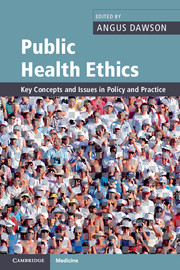Book contents
- Frontmatter
- Contents
- List of contributors
- Preface
- Acknowledgements
- Section 1 Concepts
- Section 2 Issues
- 5 Smoking, health and ethics
- 6 Infectious disease control
- 7 Population screening
- 8 Vaccination ethics
- 9 Environment, ethics and public health
- 10 Public health research ethics
- 11 Equity and population health
- 12 Health inequities
- Index
- References
6 - Infectious disease control
Published online by Cambridge University Press: 05 July 2011
- Frontmatter
- Contents
- List of contributors
- Preface
- Acknowledgements
- Section 1 Concepts
- Section 2 Issues
- 5 Smoking, health and ethics
- 6 Infectious disease control
- 7 Population screening
- 8 Vaccination ethics
- 9 Environment, ethics and public health
- 10 Public health research ethics
- 11 Equity and population health
- 12 Health inequities
- Index
- References
Summary
Introduction
Infectious diseases have been one of the major factors affecting public health in the past, and will probably remain so in the future. There was a time that physicians thought that, at some point in the future, the perils of infectious diseases would have been overcome. In the middle part of the twentieth century, progress was made in controlling diseases such as smallpox, measles, typhoid and plague. Better diet and hygiene, improved living conditions and vaccinations all helped to strengthen people's immunity against several diseases. Patients who got ill could be treated effectively with antibiotics. Morbidity and mortality due to several infectious diseases decreased significantly. However, this success story has had its limits: advances in medicine and public health have mainly benefited the developed world, whereas infectious diseases in the developing world have remained high; new viruses such as HIV and SARS have created new problems in both high- and low-income contexts; extreme multi-drug resistant forms of tuberculosis are spreading, especially among people living with HIV and AIDS; and, lastly, at the beginning of the twenty-first century, many countries and the World Health Organization started preparations for an influenza pandemic that could in the future be reminiscent of the 1918 Spanish Flu.
Medical treatment of patients with clinical symptoms is only one and probably not the most important way to control infectious diseases. The spread of disease can be reduced most effectively by controlling infection, for example by improving hygiene, by social distancing or quarantine, by raising immunity, etc.
- Type
- Chapter
- Information
- Public Health EthicsKey Concepts and Issues in Policy and Practice, pp. 100 - 117Publisher: Cambridge University PressPrint publication year: 2011
References
- 9
- Cited by



